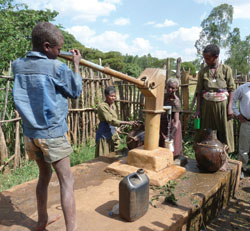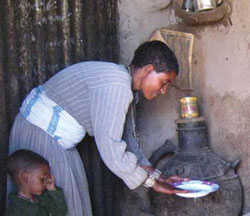16.2.2 The use of water at home
As you know, water is said to be safe to drink when it is free from pathogens, physical contaminants and chemical contaminants. This needs to apply right up to the point when water goes in the mouth. Identifying and assessing the potential risks associated with the collection and use of water is therefore a very important part of the survey (Figures 16.1 and 16.2). You need to ask users, or observe their practice, on:
- How they collect the water and the types of vessel they use (e.g. whether jerrycan, buckets or pots).
- How the vessels are handled and stored when not in use.
- Whether the vessels are used for purposes other than water collection that may contaminate them.
- Whether users know how to collect safe water and keep it safe.
- Whether the water is treated or disinfected after collection and assess the hygiene practices of users, especially young children.
 |  | |
| Figure 16.1 Collecting water in jerrycans and traditional pots. (Photo: Richard Adam) | Figure 16.2 Water storage at home. (Photo: Nancy Platt) |
16.2.1 Water source (components, protection and condition)
